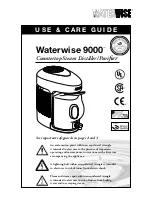
7
SYSAER R32
1.6. EQUIPMENT SAFETY DATA
Safety Data
Difluoromethane R32
Chemical Formula
CH2F2
Toxicity
Low
Classification of substance
Flammable gas – Category 1 – Danger (H220) Gases under pressure – Liquefied gas – Warning (H280)
Critical temperature (°C)
-78,4 °C @ 58,10 Bar
Upper/lower flammability
28,40 Vol. % / 13,10 Vol. %
In contact with skin
Skin contact with the rapidly evaporating liquid may cause tissue chilblains. In case of skin contact with
the liquid, warm the frozen tissue with water and call a doctor. Remove contaminated clothing and
footwear. Wash the clothing prior to re-use.
In contact with eyes
Vapours have no effect. Liquid splashes or sprays may cause freeze burns. In these cases rinse your eyes
with running water or with a solution for eye lavages for at least 10 minutes. Immediately contact a
doctor.
Ingestion
In this case, burns may result. Do not attempt to make the patient vomit. If the patient is conscious, rinse
the mouth with water. Call a doctor immediately.
Inhalation
In case of inhalation, move the patient to an area with fresh air and provide oxygen if necessary. Perform
artificial respiration if the patient has stopped breathing or lacks air. In case of cardiac arrest, perform
external cardiac massage. Call a doctor immediately.
Further Medical Advice
Exposure to high concentrations can be dangerous for individuals with cardiac problems, as the presence
of catecholamines such as adrenalin in the bloodstream may lead to increased arrhythmia and possible
cardiac arrest.
Occupational exposure limits R32: Recommended limits: 1,000 ppm v/v 8 hours TWA.
Stability
Stable product
Conditions to avoid
Increased pressure due to high temperatures may cause the container to explode. Keep out of the sun
and do not expose to a temperature >50°C.
Hazardous reactions
Possibility of dangerous reactions in case of fire due to the presence of F and/or CI radicals
General precautions
Avoid the inhalation of high concentrations of vapours. The concentration in the atmosphere shall be kept
at the minimum value and anyway below the occupational limits. Since vapours are heavier than air and
they tend to stagnate and to build up in closed areas, any opening for ventilation shall be made at the
lowest level.
Breathing protection
In case of doubt about the actual concentration, wear breathing apparatus. It should be self-contained
and approved by the bodies for safety protection.
Precautions for safe handling:
general
Only experienced and properly instructed persons should handle gases under pressure.
Use only properly specified equipment which is suitable for this product, its supply pressure and
temperature.
Purge system with dry inert gas (e.g. helium or nitrogen) before gas is introduced and when system is
placed out of service.
Purge air from system before introducing gas.
Containers, which contain or have contained flammable or explosive substances, must not be inerted with
liquid carbon dioxide.
Assess the risk of a potentially explosive atmosphere and the need for suitable equipment i.e. explosion-
proof.
Take precautionary measures against static discharges.
Keep away from ignition sources (including static discharges).
Provide electrical earthing of equipment and electrical equipment usable in explosive atmospheres. Use
non-sparking tools.
Refer to supplier's handling instructions.
The substance must be handled in accordance with good industrial hygiene and safety procedures.
Ensure the complete system has been (or is regularly) checked for leaks before use.
Summary of Contents for AC-RSR105R32HEC
Page 2: ......
Page 43: ...APPENDIX ANNEXE ANLAGE ALLEGATO ANEXO APPENDIX ANNEXE ANLAGE ALLEGATO ANEXO...
Page 78: ......










































